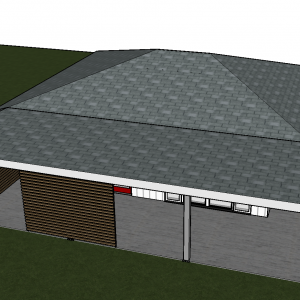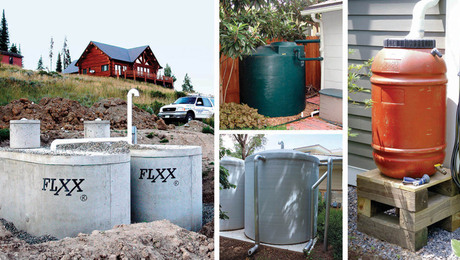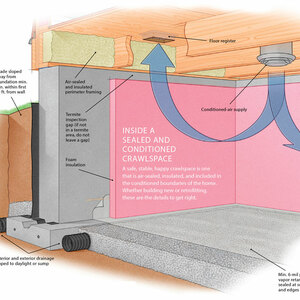Asphalt shingles on low slope/flat roof in a very specific climate?
I will be roofing the small house I’m building with asphalt shingles and I’m just barely okay with that since I had my heart originally set on metal and then composite but had to settle for asphalt for cost reasons. The majority of the roof is 4:12, even over the extensive West patio. The roof over the North patio sharply flattens at one point, though, to be closer to 1.5:12… or essentially “flat”. I realize that shingles are no longer an official option for that part of the roof — but all of the options I do see are simply a bridge too far! I compromised enough to settle on shingles for the majority of the roof and having to compromise again with an even worse aesthetic option thoroughly ruffles my feathers. Thus, I want to continue the shingle install on the low slope / flat section of the roof, as well.
Wait wait wait! I know that doing so is definitely not recommended. I know that it will instantly void any and all warranties on the shingles. I know that it would be patently foolish in any climate with snow or ice. But hear me out.
I live in Phoenix AZ; it never snows here; there is never ice buildup; it barely rains at all; the wind only rarely blows from the North (up to 10% of the time in the Dec-Feb months); and the winds never get to any substantial speeds compared to most parts of the country.
So I’m thinking that I will apply a self-adhered underlayment over the low slope section of the roof — something like Grace Select or even Grace Ice and Water Shield (since it is thicker). That will serve as my “true” waterproof layer. I would then attach the shingles on top almost normally but squished just a bit to have a little less of a reveal. My thinking is that the shingle layer will mostly just provide UV protection for the waterproof underlayment. There is zero chance of ice or snow building up underneath the shingles. There is extremely low chance of wind driving up the shingles (rarely from the North and relatively slow). Any standing water will tend to evaporate pretty quickly and even if not, the Grace Select is waterproof. If there was a freak (and I do mean freak) wind storm like a micro-burst blowing South and a few shingles did blow off or shove water underneath the shingles, then no big deal because of the waterproof underlayment… and besides, MOST of the low slope part is just over a patio, not over the main part of the house.
I’m not hoping for official validation here because that’s unlikely to come. Instead, I want to know, is my logic fundamentally flawed in some way? That is, is my approach here a terrible idea even in my specific climate? If so, what factor am I completely missing?
Heck, let me know even if it’s just a bad idea and not a terrible one. Just let me know why you think it’s bad.



















Replies
It is bad idea as you realize. If the flat roof were over living space I definitely would not chance it. It is very wrong, but it kind of sounds like you are ready to spin the chamber (Russian Roulette). If ice, water and high winds are not a concern I can understand why your mind is going in this direction. I would not feel comfortable doing this as I think the first wind storm will blow shingles right off of the roof and you have to realize climate change is leading to more severe weather events. I think you need to ask yourself if it is cheaper to replace a cheap roof in a very short period of time with the proper roof or install the proper roof the first time. If you are absolutely sold on using shingles I would not invest a lot of $ on soffit etc below as there’s a good chance it will be damaged. Exposed rafters that can dry out from occasional leak would be best. If you have building inspections in your area the inspector will not pass (unless he’s inept) and you will not be allowed the shingles anyway. Good luck, you’ll need it.
Yeah, climate change is already affecting weather patterns around here and they aren't quite as predictable... but so far, the changes are mostly intensifying existing patterns. And even vigorous wind storms rarely hit 50mph and are ALWAYS coming from the South and variants. North winds are much weaker even at their max. If I install shingles rated at 130mph installed on a proper slope with recommended overhangs then even HALVING the rating with low slop and a reduced overhang should still be more than enough.
And why would the roof get damaged, beyond potentially losing shingles? My goal would be to install a waterproof layer under the shingles.
I can respect trying to think out of the box, but it is a risk that you are taking. It is against code and will not be allowed by an inspector (unless your code situation is different from any that I’m aware of or inspector misses it), so you may not be able to install anyway. It is against code, against manufacturers instruction and warranty, this is a definite deal breaker for me.
If it has not passed the testing of multiple roofing manufacturers than in my opinion it’s not a viable option. I do believe if it were to be acceptable the roofing manufacturers would be advertising and selling shingles for a 1/12, they are not in business to lose $. If you owned a roofing company and a client asked you to install as you are considering would you do it? Would you warranty your work? It may not leak this is true, but it is a gamble and not advisable. The argument of a shingle rated at 130 mph is not applicable b/c shingling a 1/12 is not allowed anyway (it hasn’t been tested). From my personal experience (I live in high wind area) high winds effect a low slope greater than a high slope as horizontal wind is driven under the shingles of low pitch easier. My first home had 3 different pitches 8/12, 6/12 and 4/12. After a major windstorm half of the 4/12 section was blown off of the roof the others remained. Sections of 8/12 and 6/12 both faced the same direction as the 4/12, so it had to be the low pitch that made the difference. The ice and water shield went with it in chunks as the nails probably hooked into the material and pulled it off the deck.
Maybe calling a local roofer and/or inspector will give you the advise you need as a lot of us on the forum are from areas that this kind of construction would not even register in our brain.
Get some self-adhesive roll roofing that matches the color of your shingles.
One example:
https://www.tarcoroofing.com/products/roofapp/low-slope-roofing/self-adhered/easystick-plus
Thanks for the example. Yes, that's exactly the bug-ugly roofing that I was referring to and that I so strongly object to.
The roof is a major aesthetic feature of any house but makers of flat roof products just toss aside any thought of that with "no-one will see it anyway"
The real question is why would you include such an ill-advised transition to roofing slope?
If you are building, the roof should be raised so that a constant slope is maintained to the edge of the roof.
a. Your roofing solution is bad and wrong. Millions of $$ have been spent to determine the proper use and installation of shingles for durability and for consumer target. Considering yourself the exception is foolhardy.
b. Rethink the porch design. What's the motivation behind it? Are you looking for a flat, low profile roof? How would your aesthetic respond to the main roof extending to the porch eaves? If you really like and are committed to the low profile design, use materials suitable for this condition.
EPDM
https://www.google.com/search?channel=cus2&client=firefox-b-1-d&q=epdm+roofing
Liquid Applied Membrane
https://usa.sika.com/en/construction/liquid-applied-roofing.html
Frankie
a. It's actually not uncommon to be an exception to a LOT of general building rules here in Phoenix, so it wouldn't be unheard of to be an exception to this one, too. My exception would mostly be that I haven't seen this done even here. But... all of the testing they have done have resulted (as far as I can tell) in just a few failure points and I can't see how any of those apply to this house.
b. Redesigning the porch is impossible for countless reasons.
Related question: how is the Sika liquid applied membrane any different from the waterproofing underlayment I'd put under the shingles? They would both be monolithic sealed surfaces.
FWIW. Not a roofing expert but have done on my personal house what you are suggesting. Ice and water shield under comp shingles. Have had no problems for over 10 years now. It is in a fairly protected area. My insurance co approved. Good luck
Edit: Yes, 4" Shingle exposure
Based on all your caveats I'd say go for it. Life has it's risks and this sounds like a low one, all things considered.
Just use a good peel and stick underlay, there are a lot of options, some better than others. A 4'' exposure on the shingles isn't a bad idea either....
As a building inspector in a coastal area I'm fundamentally opposed to what you're suggesting and would obviously never approve it. The code is the code and in this instance there is absolutely no room for interpretation.
As a homeowner and recovering scofflaw however, and considering we're talking about a patio rather than livable area, I say do it if you can get away with it. You seem well aware of most of the risks and have convinced me that it may not cause you the problems that it would someone in another climate.
One additional consideration I would bring up is that the sun will hit a 1.5:12 slope at a much more direct angle than a higher slope, therefore aging it faster. I live in a climate similiar to yours (albeit with much more rain). We average 230+ sunny days a year with highs in the mid to high 90's for four months a year. A "30 year" architectural shingle roof on a 4/12 or greater slope here tends to last 15-21 years. I wouldn't be surprised if that was reduced somewhat on a low slope.
To anyone following along... I had a separate inspection yesterday and so used the opportunity to pepper my building inspector with questions.
It seems that in my town, inspectors do not look at the roofing at all for residential construction -- only commercial. I described some pretty outlandish hypothetical roofing scenarios and was told that all would be fine from the town's point of view since there is no inspection that would include them!
I then followed up asking to pretend that this was a commercial building and not residential. Would he pass or fail the roof that I described above in that scenario. That ended up being a grey area, apparently. His thinking was that since 1.5:12 "rounds up" to 2:12, he would likely pass it as long as the roofing material all was approved for low slope usage and the instructions for low slope installation were followed closely.
So yeah, based on multiple reports in this topic of people who did something similar with no issues and seeing that there is no authority that will (or even would, apparently) stop me, I'm going to go ahead with my plan.
Hey Kurt,
As you are realizing builders are mostly pretty conservative. Over the years I've dealt with many professionals, especially engineers, and the tendency to build in a big fudge factor is unavoidable unless it's your own house and doing fun stuff is OK. Codes are often built up over many iterations by making them stricter almost never the reverse. The room for innovation and common sense is small unless you are well outside the reach of such oversight.
There are, of course, people who don't know what they are doing and don't know where the risks actually lie so they don't know how to bypass the rules safely. It seems to me you have put in a lot of thought and weighed the evidence. And by the way, I've seen exactly what you describe doing succeed even in wetter places. Over a patio I can't see any serious risk at all. It would be even worse to try and address the situation with a metal roof unless you want to pay big bucks.
what about a rubber roof? Also I didn't think a metal roof would cost that much more than shingles. screw it down and walk away.